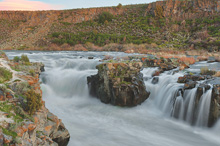No products in the cart.
The River Plain

All along the Snake
By Gary Oberbillig
As a youngster in the 1940s I spent a lot of time in Glenns Ferry, where we often saw coyotes in the less-populated areas along the Snake River. If I saw a coyote walking with a halting, uneven gait and biting at unseen things, I beat a fast retreat, for coyotes can carry rabies. One of my great-uncles was bitten by a rabid coyote and his recovery required a very painful inoculation process.
We had to watch where we put our hands and feet to avoid rattlesnakes. The common one in Idaho is the blotchily patterned Great Basin rattler but my stepfather said he occasionally saw a little sidewinder that had small hornlike protrusions by the eyes and a peculiar sideways-looping locomotion across the sand. Quite a remarkable adaptation for sliding over loose ground.
Most people think of Idaho as mountains piled on top of mountains, and there is a kind of truth to that. The giant granite Idaho batholith was thrust up only to be scraped down by the glaciers, leaving the land furrowed in rugged peaks and valleys as the streams carved gorges with patient and inexorable power over mountainous eons of time.
Tall spicy sagebrush, basalt lava outcrops, impressive anthills made by the big red ants, and green water are the signatures of the Snake River Plain, which starts near the steaming geyser basins of Yellowstone and alternately meanders or races to where the deep gorge of Hells Canyon cuts down through the peaks of the Seven Devils.
This content is available for purchase. Please select from available options.
Purchase Only
Purchase Only

